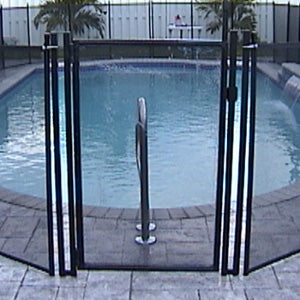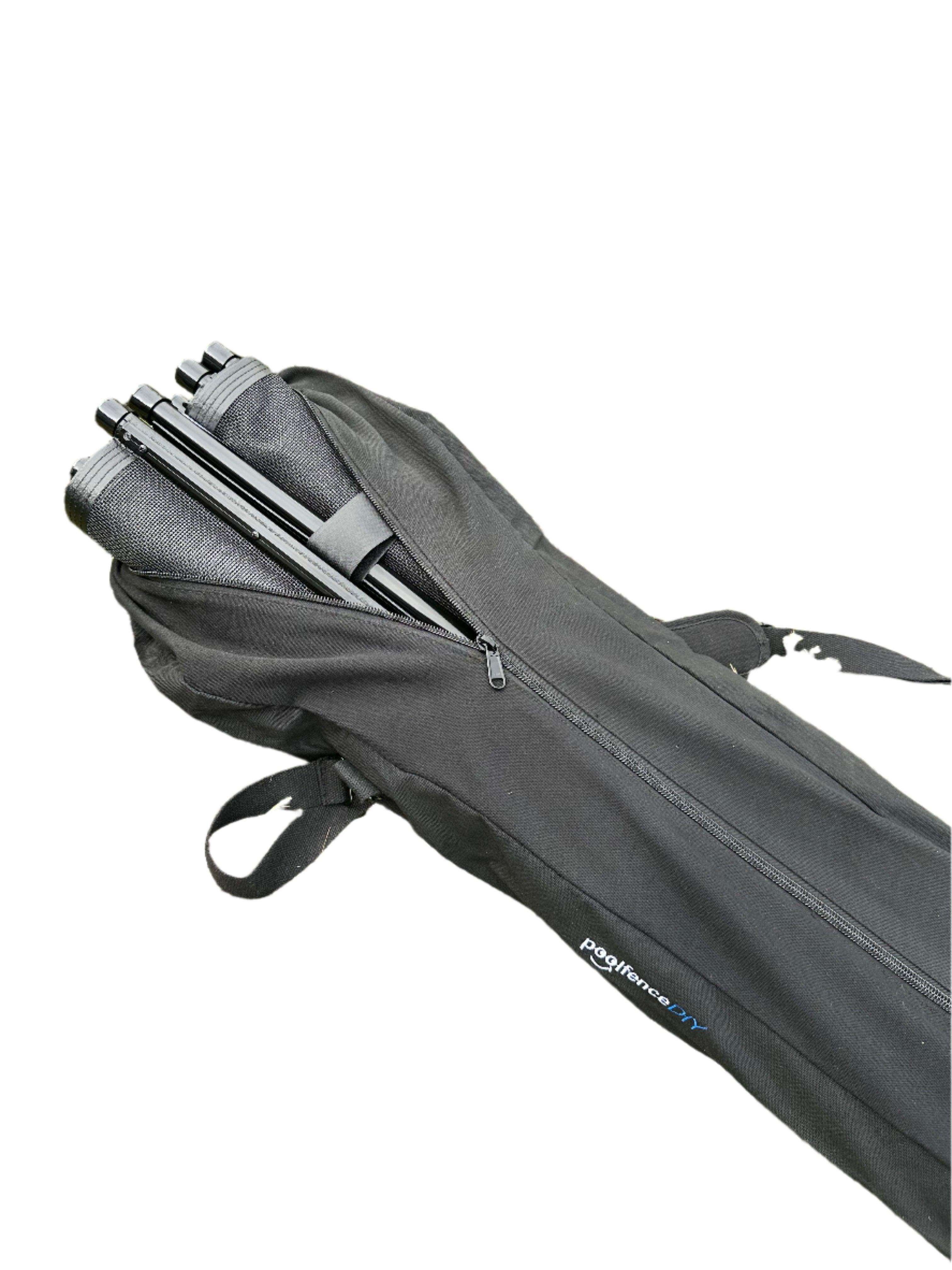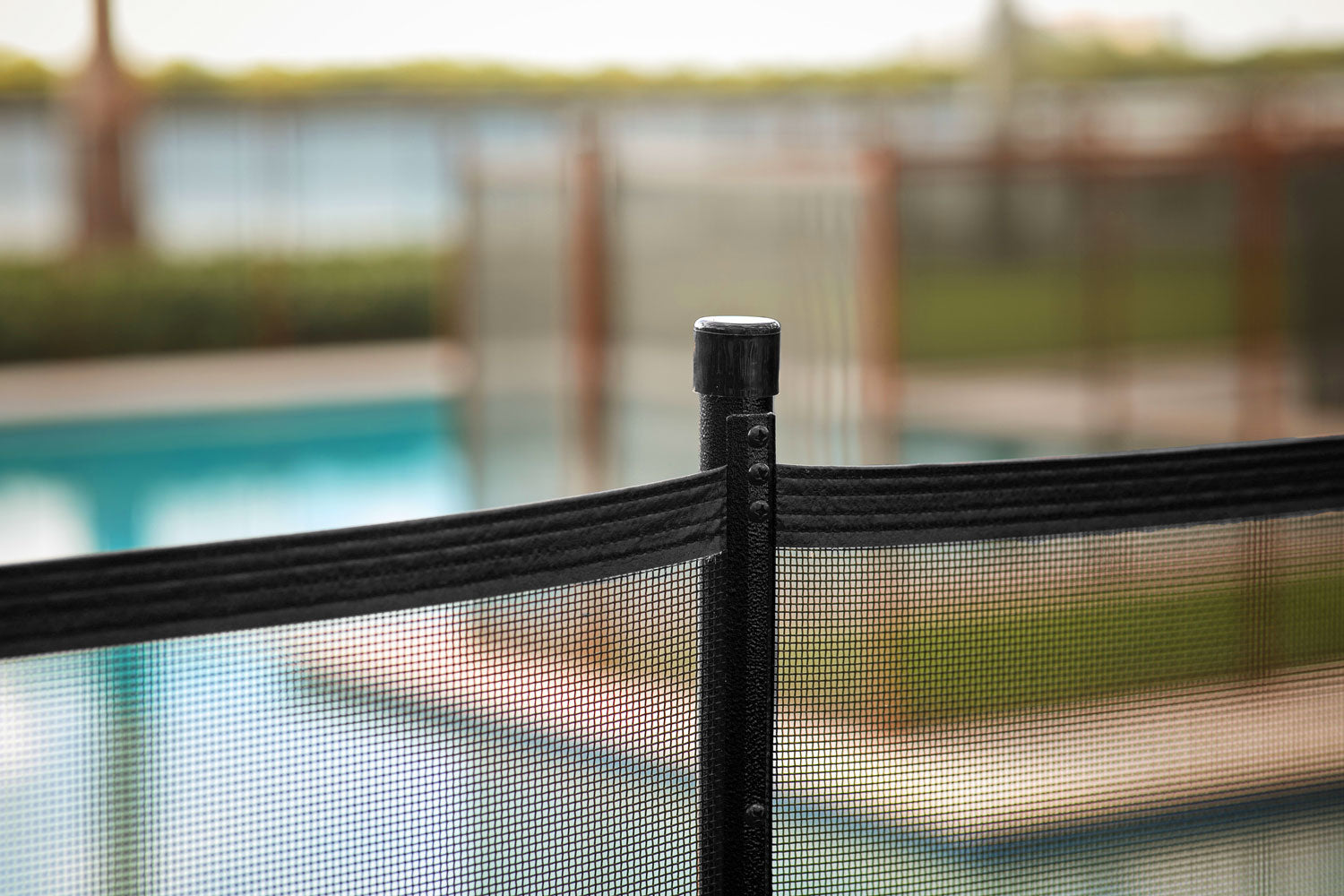Giros de 90 Grados
Hay ciertas circunstancias en las que la cerca no se puede instalar con giros regulares y se requiere que haga un giro de 90 grados. Esto generalmente ocurre por dos razones: una es que el giro es demasiado apretado para ser usado con un solo poste como el pivote, la otra razón es que el cliente quiere que delinee perfectamente su plataforma que contiene giros de 90 grados y el cliente no razón quiere un giro regular porque no no quiere tomar atajos y perder espacio en cubierta. Para lograr esto, hará más cortes que en una instalación estándar, por lo que se recomienda cobrar un poco mas por el trabajo extra y el material que se desperdiciara.
Pasos
- El primer paso para instalar un giro de 90 grados es marcar el giro (vea el diagrama A1). La parte más importante de marcar el giro de 90 grados, es asegurarse de girar la plantilla y trazar una línea en el giro. Esto permitirá que la malla de la cerca quede floja y permitirá que los postes giren para que el cerrojo pueda conectarse en el espacio estándar de 2 1/2" sin estar demasiado apretado. Para una vista de cerca del giro, consulte el diagrama A2.


- El siguiente paso es taladrar estos ángulos correctamente para que la cerca pueda conectar con el giro de 90 grados. El diagrama A3 muestra cómo deben taladrarse los ángulos para este ejemplo. Los giros de 90 grados consisten en dos postes que se conectan. Esto significa que ahora tienes la fuerza de dos postes que van a conectar cuando se agregue tensión. Por eso, no tiene que inclinar el taladro tanto como lo haría si estuviera trabajando con un solo poste.

NOTA: No intente hacer un giro de 90 grados con un solo poste. Si intenta completar un giro de 90 grados con un solo poste, el resultado podría ser un efecto de inclinación en el poste. Demasiada tensión en el poste aumentará la probabilidad de que el poste se rompa y también se vea estéticamente incorrecto. El diagrama A4 ilustra cómo debe verse la cerca después de perforarla y antes de conectarla.
Design Your Own Pool Fence
Calculator Step 1 of 14
Installing a Complete or Partial Fence?
Will your fence go completely around the pool, or will you be attaching it to an existing wall or barrier?
Fence will go completely around the pool
Fence will be attached to existing fence or wall


Calculator Step 2 of 14
Fence Height
($7.90 / foot)

*MOST POPULAR*
($10.84 / foot)

*Meets California code*
Calculator Step 3 of 14
Fence Color


Calculator Step 4 of 14
Total Fence Length
What is the total length in feet you will need for your fence?
If your fence will be completely in a hard surface, e.g. concrete, thick wood, tiles over concrete or a hard subsrate, stone, etc., leave the number of feet over grass as "0" and vice versa.
If your fence will be partly in a hard surface and partly in grass, enter the total number of feet of fence you will need in each surface into the two fields below.
Calculator Step 5 of 14
Arched or Flat Top Gate
Your self-closing gate can either have the standard flat top or be upgraded to an arched top.


Calculator Step 6 of 14
Self-Closing, Self-Latching Gates
How many self-closing, self-latching gates would you like?
Gates that will be in a hard surface
Gates that will be in grass/dirt
The Pool Fence DIY system includes a manual opening at no charge. Self-closing, self-latching gates are recommended by everyone from the American Academy of Pediatrics to the Consumer Product Safety Commission to the National Drowning Prevention Alliance. Besides being safer, they are also MUCH more convenient. A must if you have older children who use the pool.
Calculator Step 7 of 14
90° Turn Posts
Are you making any 90° turns? If yes, how many?

Calculator Step 8 of 14
Accessories
This item is HIGHLY recommended to ensure the fence is properly installed.
Will you need the Pool Fence DIY Drilling Guide with Bubble Level?
$117.56 $98.05
Sorry, item currently out of stock.

Calculator Step 9 of 14
Rotary Hammer Drill
The Pool Fence DIY Rotary Hammer Drill is the recommended hammer drill for installing this style of mesh pool fencing. Having the right tool for the right job makes installation go smoother. It also comes with a 16" long x 5/8" diameter drill bit, which is the recommended bit for this installation and is the correct length for the Pool Fence DIY Drill Guide, which is highly recommended.
$174.39 $138.89
Sorry, item currently out of stock.

Calculator Step 10 of 14
Drill Bits
Do you need the correct bit for your hammer drill (or an extra bit)?
Pool Fence DIY SDS-Plus Masonry Bit 5/8th Inch Diameter by 16 Inch Length (compatible with the Pool Fence DIY Rotary Hammer Drill)
Pool Fence DIY Standard (Smooth Shank) Masonry Bit 5/8th Inch Diameter by 16 Inch Length (for non-SDS compatible hammer drills)
$16.08 each

Out of Stock

$15.58 each

Out of Stock

Calculator Step 11 of 14
Do you want storage bags for your fence sections?
Our Pool Fence Section Storage Bag offers a reliable and convenient way to store and transport your fence sections. Each bag is designed to hold two 4-foot sections and includes two smaller straps to wrap each section securely, keeping everything compact and ready for storage. Made from heavy-duty canvas with a strong zipper, this bag is built for durability. Rubber pads on the bottom prevent canvas wear and slipping when the bag is stood on end. With a comfortable shoulder strap for easy carrying, this storage bag is an ideal choice for off-season storage or anytime your pool fence is not in use.
$39.00 each
Sorry, item currently out of stock.

Calculator Step 12 of 14
How many Solar Lights do you want on your fence?
$8.18 each
Quantity:
Sorry, item currently out of stock.


Calculator Step 13 of 14
Do you want to add Omni-Hangers to your fence?
How many two-packs you would like with your fence?
$21.79 per two-pack
Quantity:
Sorry, item currently out of stock.




